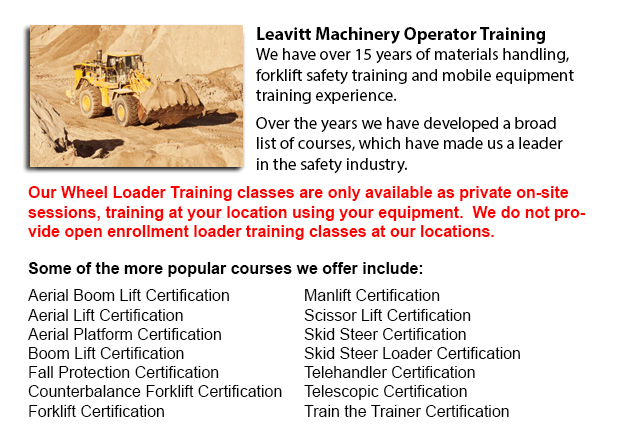
Oshawa Wheel Loader Operator Training - To be able to raise substantial loads, industrial cranes use pulleys and levers. In the past, Roman people utilized cranes so as to erect big monuments making the origin of these equipment at least two thousand years ago. Several Medieval churches utilized cranes in their creation as well as the Egyptians may have relied on them when constructing the pyramids.
The modern type of a crane can be either complex or simple, and cranes vary depending on their use. Mobile cranes, for example are rather simple. A telescopic boom or steel truss mounts its movable platform. A system of pulleys or levers raises the boom and there is often a hook suspended. These cranes are frequently utilized for earthmoving or demolition by changing the hook out with another piece of equipment like for instance a wrecking ball or a bucket. Telescopic cranes have a series of hydraulic tubes that fit together to form the boom. These models can also be mobile.
Conventional wheels, or particular wheels intended for a caterpillar track or railroad track enable these mobile booms to be able to navigate unpaved and uneven surfaces.
Rough terrain and truck mounted cranes are mobile too. Outriggers are placed on the truck mounted unit so as to enhance stability, while rough terrain cranes have a base which tends to resemble the bottom of a 4-wheel drive. These cranes are outfitted to be able to work on rough ground making them best in the construction industry for example.
Normally utilized on railroads and in ports, the Gantry crane can move and unload large containers off ships and trains. Their bases include massive crossbeams which run on rails to be able to lift containers from a location to another. A portainer is a special type of gantry that moves supplies onto and off of ships in particular.
Floating cranes are attached on pontoons or barges and are one more vital piece of equipment essential to the shipping business. Because they are places in water, they are utilized for different services comprising port construction, building bridges and salvaging ships. Floating cranes are capable of handling really heavy loads and containers and similar to portainers, they could even unload ships.
Loader cranes are fit onto trailers along with hydraulic powered booms so as to load things onto a trailer. If not being used, the jointed sections of the boom can be folded down. This type of crane can be likewise considered telescopic since a part of the boom could telescope for more versatility.
Normally found in automated warehouses, stacker cranes tend to follow an automatic retrieval system and could work using a remote. These cranes are outfitted with a forklift machinery and can be found in large automated freezers, obtaining or stacking foodstuff. Using this type of system enables personnel to remain out of that cold situation.
Tower cranes are frequently the tallest cranes and normally do not have a movable base. They must be put together part by part. Their base resembles a long ladder along with the boom at right angles to the base. These cranes specialize in the construction of tall buildings and are often affixed to the inside of the building itself throughout the construction period.
-
Oshawa Scissor Lift Operator Certification
Oshawa Scissor Lift Operator Certification - North American regulators recommend that worksites need operators of scissor lifts, booms or aerial work platforms to obtain certification training. Scissor lift operator certification is not mandatory, bu... More -
Narrow Aisle Forklift / Order Picker Training / Electric Pallet Jack / Electric Pallet Truck Training in Oshawa
A pallet lift is a model of equipment dedicated in the moving of pallets of many dimensions and weights. They might be utilized as an appendage for platform lifts, cranes and other types of heavy machinery or be applied on their own. Pallet hoists ar... More -
Oshawa Crane Operator Certification
Oshawa Crane Operator Certification - The process to permit people to be able to operate certain kinds of cranes is to take crane operator certification training to get certification. The certification process incorporates classroom learning, hands-o... More -
Oshawa Aerial Platform Training
Oshawa Aerial Platform Training - Aerial platform lifts might be utilized to accomplish a lot of unique tasks executed in hard to reach aerial places. A few of the odd jobs associated with this style of lift include performing routine repair on build... More -
Oshawa Forklift Certification Schools
Oshawa Forklift Certification Schools - Forklift Certification is mandatory within North America. Hence, forklift training programs are important both for companies and for people seeking jobs in industries as forklift operators. Forklift training fo... More -
Oshawa Heavy Equipment Ticket
Oshawa Heavy Equipment Ticket - Depending on the nature of the job at hand, the type of construction equipment that a heavy equipment operator makes use of varies. Each and every type of machine is built to perform specific jobs in the most effective... More -
Oshawa Heavy Equipment Certification
Oshawa Heavy Equipment Certification - Large pieces of machines and heavy-duty vehicles are usually known as heavy equipment. This broad term includes utility vehicles from forestry and agricultural implements to civil engineering vehicles, construct... More -
Oshawa Overhead Crane Safety Training
Oshawa Overhead Crane Safety Training - The overhead crane safety training program is meant to equip the operators with the right skills and knowledge in the areas of: crane safety precautions, accident avoidance, materials handling, and equipment an... More

Forklift Certification Oshawa
TOLL FREE: 1-888-254-6157
Oshawa, Ontario
forkliftcertificationoshawa.com
Email Us
About Us


